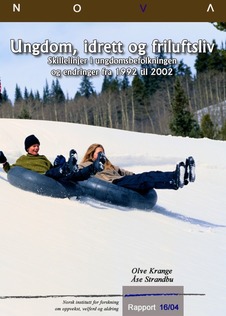| dc.description.abstract | This report investigates changes in sports activities and exercise habits among Norwegian youth in the period of 1992 to 2002. Do sports organisations manage to recruit broadly? Are there differences between youth according to gender, their belonging to the majority or minority population, their class origin or their place of living - when it comes to membership in sports clubs? Do young people of different belongings exercise just as often? And do they take part in outdoor recreation to the same degree? These are the addressed issues in this report. The data material are two nation wide surveys, Ung i Norge 2002 and Ung i Norge 1992. At both points of data collection, almost 12000 youth from all over the country participated, divided on the three grades in the Norwegian lower secondary school [ungdomsskolen] and the three grades in upper secondary school. The response rate of both surveys is good, and the surveys are representative for Norwegian youth aged 13 to 19. A main finding is that Norwegian youth exercised equally often in 2002 as in 1992. There has been a decline in the proportion of youth who are members of sports clubs. 47 per cent of the teenagers were members of a sports club in 1992, while the proportion in 2002 was 40 per cent. However, there has been no decrease in the proportion who has been exercising in an athletic club. Neither has the proportion of youth training on their own decreased. In other words, Norwegian teenagers are as active in 2002 as in 1992, but fewer are sports club members. Traditional outdoor activities as walks in the woods and fields, berry-picking, fishing trips and skiing were the only activities where we were able to observe a decline from 1992 to 2002. The survey shows that even if sports clubs recruit on a broad basis, some groups are under-represented. The dimensions studied in this report are gender, place of living, social class and majority/minority origin. In short, the investigation shows that boys and girls exercise equally often, but that athletic clubs attract more boys. Further, it appears that economic and cultural resources at home have an impact on the young peoples training habits as well as on their disposition to become members of sport clubs. Still, these connections are not strong. In additions, place of living has influence. Teenagers living in large, densely populated areas are more often than youth in big cities members of sports clubs, and are more often going for walks in the woods and fields. Yet, place of living is not of great importance for the young people’s training habits either. On the other hand, there are significant differences between teenagers from the majority and the minority population regarding sports club membership. This is particularly true when it comes to minority girls, who less than others take part in organised sports. Concerning exercising on their own/independent exercise, the distinction between majority and minority population is much less pronounced. Some of the under-representation of minority teenagers may be accounted for by conditions which also influence ethnic Norwegian’s probability to sign up membership in sport clubs, as for instance class origin, school achievements and place of living. But, also when controlling for these factors, a distinct difference remained between the groups. | en |
| dc.description.abstract | Basert på to landsrepresentative datasett, Ung i Norge 1992 og Ung i Norge 2002, studeres endringer i unges idretts- og friluftslivsaktiviteter. Forskjeller etter alder, kjønn, sosial klasse, bosted og minoritet/majoritetsbakgrunn beskrives og kommenteres. Et hovedfunn på idrettsområdet er nedgang i andelen medlemmer, men stabilitet i aktivitetsnivå. Ungdommer i Norge trente like ofte i 2002 som i 1992. Når det gjelder tradisjonelle former for friluftsliv, har deltakelsen gått ned. Deltakelsen i idrett synker med økt alder. Forskjellene mellom gutter og jenter, unge med ulik klassebakgrunn og bosted finnes, men er relativt små. De tydeligste forskjellene finnes langs dimensjonen minoritet/majoritet. Unge med foreldre fra ikke-vestlige land er sjeldnere enn andre ungdommer med i idrettslag. Og for denne gruppen er også kjønnsforskjeller betydelige. Konklusjonen er at idrett og friluftsliv rekrutterer i brede lag av ungdomsbefolkningen, men at unge med foreldre fra ikke-vestlige land er en gruppe idretten og friluftslivet har større problemer med å fange opp. | no_NB |
